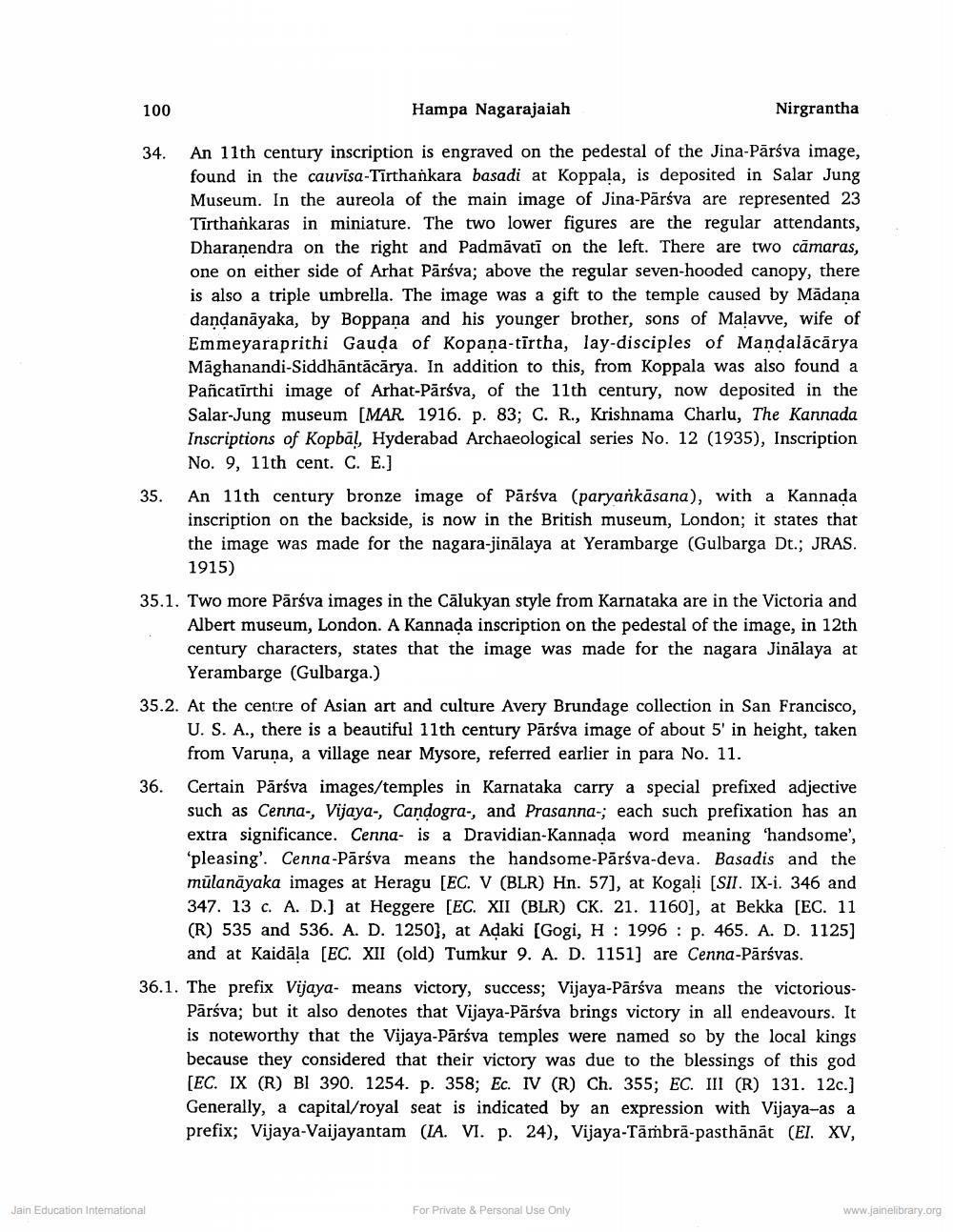________________
100
Hampa Nagarajaiah
Nirgrantha
34. An 11th century inscription is engraved on the pedestal of the Jina-Pārsva image,
found in the cauvīsa-Tirthankara basadi at Koppala, is deposited in Salar Jung Museum. In the aureola of the main image of Jina-Pārsva are represented 23 Tīrthankaras in miniature. The two lower figures are the regular attendants, Dharanendra on the right and Padmăvati on the left. There are two câmaras, one on either side of Arhat Pārsva; above the regular seven-hooded canopy, there is also a triple umbrella. The image was a gift to the temple caused by Mādana dandanāyaka, by Boppana and his younger brother, sons of Malavve, wife of Emmeyaraprithi Gauda of Kopana-tīrtha, lay-disciples of Mandalācārya Māghanandi-Siddhāntācārya. In addition to this, from Koppala was also found a Pañcatīrthi image of Arhat-Pārsva, of the 11th century, now deposited in the Salar-Jung museum (MAR 1916. p. 83; C. R., Krishnama Charlu, The Kannada Inscriptions of Kopbāl, Hyderabad Archaeological series No. 12 (1935), Inscription
No. 9, 11th cent. C. E.] 35. An 11th century bronze image of Pārśva (paryankāsana), with a Kannada
inscription on the backside, is now in the British museum, London; it states that the image was made for the nagara-jinālaya at Yerambarge (Gulbarga Dt.; JRAS.
1915) 35.1. Two more Pārsva images in the Cālukyan style from Karnataka are in the Victoria and
Albert museum, London. A Kannada inscription on the pedestal of the image, in 12th century characters, states that the image was made for the nagara Jinālaya at
Yerambarge (Gulbarga.) 35.2. At the centre of Asian art and culture Avery Brundage collection in San Francisco,
U. S. A., there is a beautiful 11th century Pārśva image of about 5' in height, taken from Varuna, a village near Mysore, referred earlier in para No. 11. Certain Pārśva images/temples in Karnataka carry a special prefixed adjective such as Cenna-, Vijaya-, Candogra-, and Prasanna-; each such prefixation has an extra significance. Cenna- is a Dravidian-Kannada word meaning 'handsome', 'pleasing'. Cenna-Pārśva means the handsome-Pārsva-deva. Basadis and the mūlanāyaka images at Heragu [EC. V (BLR) Hn. 57], at Kogali (SII. IX-i. 346 and 347. 13 c. A. D.) at Heggere [EC. XII (BLR) CK. 21. 1160], at Bekka [EC. 11 (R) 535 and 536. A. D. 1250], at Adaki (Gogi, H: 1996 : p. 465. A. D. 1125]
and at Kaidāla [EC. XII (old) Tumkur 9. A. D. 1151] are Cenna-Pārsvas. 36.1. The prefix Vijaya- means victory, success; Vijaya-Pārśva means the victorious
Pārsva; but it also denotes that Vijaya-Pārsva brings victory in all endeavours. It is noteworthy that the Vijaya-Pārśva temples were named so by the local kings because they considered that their victory was due to the blessings of this god [EC. IX (R) BI 390. 1254. p. 358; Ec. IV (R) Ch. 355; EC. III (R) 131. 12c.] Generally, a capital/royal seat is indicated by an expression with Vijaya-as a prefix; Vijaya-Vaijayantam (IA. VI. p. 24), Vijaya-Tāmbrā-pasthānāt (EI. XV,
Jain Education Intemational
For Private & Personal Use Only
www.jainelibrary.org




